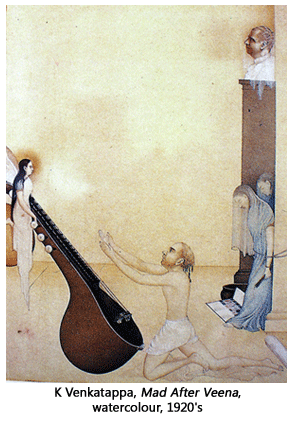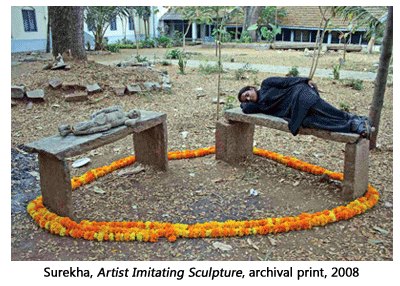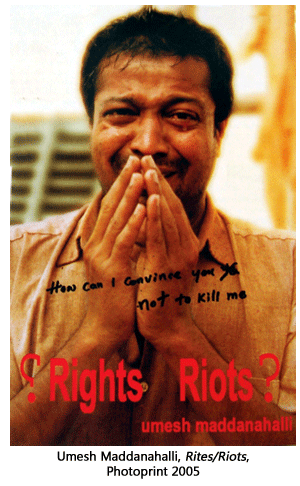- Prelude
- Editorial
- Subodh's 'return home'
- A Conversation with TV Santosh
- It's a War Out There
- Raqib Shaw
- Illusions in Red from a very British Indian Sculptor
- Stand Alone: Shibu Natesan
- Reading Atul Dodiya
- Bharti Kher: An Obsession for Bindis
- Bose Krishnamachari
- The Image - Spectacle and the Self
- From Self-depiction to Self-reference: Contemporary Indian Art
- GenNext: The Epitome of New Generation Art
- Kolkata's Contemporary Art A Look in the Mirror
- Innovation Coalesced with Continuing Chinese Qualities
- Kala Bhavana-Charukala Anushad Exchange Program
- Montblanc Fountain Pens
- Dutch Designs: The Queen Anne Style
- Bangalore Dance Beat
- Decade of change
- Distance Between Art & It's Connoisseur
- What Happened and What's Forthcoming
- 3rd India Art Summit
- New Paradigms of the Global Language of Art
- Black Brown & The Blue: Shuvaprasanna
- Art Events Kolkata
- Musings from Chennai
- Art Bengaluru
- Printmaker's Season
- Mumbai Art Sighting
- The Pause of Profound Stillness
- Previews
- In the News
- The Rebel Queen: An icon of her own times yet looked down upon
ART news & views
From Self-depiction to Self-reference: Contemporary Indian Art
Volume: 3 Issue No: 14 Month: 3 Year: 2011
by H A Anil Kumar
Referring to 'self' is something that comes only after coming to terms with the very idea of defining self itself, in visual representations in the recent history of Indian art.
The idea of self is a media-specific subject, unlike, say, a 'landscape' which might meander between poetry and painted imageries, as a mutually similar theme. The moment self disconnected itself from the genre of self-portraiture, one specific thing that occurred about  it was that self was no more specific/specified like a recognizable genre of portraiture, landscape and the like. Secondly, self in-itself shifted over from being an 'end' to a 'means'. In other words, the understanding of contemporary in Indian art depends a lot on how the self shifted its long held position from 'being' an end to 'becoming' a means. On the other hand, as if to congratulate the agent that liberated its-self from being cornered ('end'ed, that is), the self articulated contemporary nuance, instead of trying to define it, as it might have had done with Modernity previously, in an another earlier age.
it was that self was no more specific/specified like a recognizable genre of portraiture, landscape and the like. Secondly, self in-itself shifted over from being an 'end' to a 'means'. In other words, the understanding of contemporary in Indian art depends a lot on how the self shifted its long held position from 'being' an end to 'becoming' a means. On the other hand, as if to congratulate the agent that liberated its-self from being cornered ('end'ed, that is), the self articulated contemporary nuance, instead of trying to define it, as it might have had done with Modernity previously, in an another earlier age.
In other words, ambiguity is to contemporary art as is media to Greenbergian Modernity/Modernity (despite the difference between the two words existing on either side of the bar and no matter how much Greenberg barred both from each other). The notion of self in contemporary times, 'articulates' contemporariness itself instead of 'defining' it. Articulation saves definition from the cliché of absolutism. The relation between contemporary and self lies in the selflessness of contemporary art, in the populist sense. Herein self always convinces the physical appearance of the creator in not being insular-in-itself but acting as a catalyst for something beyond the physicality.
Interestingly self also saves 'readings' (both the perceptual/art historical ones and expressive/representational ones) from being subservient to 'creations', when the art community and pedagogy together empirically treat them as if one is not integral to the other. Hence contemporary according to the dictum of self is not something that happen(s)ed 'after' Modern but is a re-look at the very Modern (and beyond, in an anti-chronological way, to an indefinite period) art, historically/representationally. By recent history I do not mean the images produced in the recent times as much as the 'act' of delving into the images, in recent times. In other words, the idea that 'there is an object out there, which is shifting from Modern to Postmodern/Contemporary and one needs to read it' is the most commonly held belief amongst the practitioners of art --in theory, in general and practice in particular.
In an attempt to continue as to how we could come to terms with an attempt to define contemporary in/of/about Indian art, I would like to consider a few works, produced roughly over a period of a (recent) century, from a specific geography and ponder as to whether 'contemporary' is not a set of works but is a set of reading habits into works and their situations, irrespective of their origin from over varying times, which, incidentally, are bound to  have implicated some of that habit into the 'making' of the work itself!
have implicated some of that habit into the 'making' of the work itself!
Consider the painting Mad After Veena (1920s) painting by K Venkatappa, Rights/Riots installation-performance (2005) by Umesh Maddanahalli, Artist Imitating Sculpture (2008), a Photo-Performance by Surekha and Imaginary Homeland (2011) painting by Ramesh Chandra. Before we delve into the intricacies of this production, a caution about choosing (these) individual works by individual artists, as the only way of mentioning examples. It is a modernist choice to bring in individual works together for a discourse. The other option is to consider the body of works by individual artists and a body of artists which inevitably includes their body of works. It means an indication that there might or might not be a preset module for a contemporary approach to 'discussing' 'art' that is completely independent of the modernist structure of art discourse or consideration of work as a unit/single/series.
Curatorial attempts should be given the credit of breaking this monopoly of 'unit'ising of artworks/artists.[1] Thus reading each one of them in comparison to the next one is a modernis(t)m-generated habit, which this sentence attempts in essence but escapes due to lack of its description! More than what we can read into them, the interventionalist challenge in addressing the politics behind that module itself perhaps means shifting from Modern to Contemporary while doing something that seems very similar.
Mad After Veena is a visual response by an ex-student (K.Venkatappa) to an ex-guru's (Abhanindranath Tagore) admonition that the former has shifted his media of expression from visual arts to music. [2]
ANT 'wrote' a 'letter' to KV that he has shifted his concern from 'visuals' to the 'musical'. KV answered it through this 'painting'. The discourse of puri(ty)fication of media that ANT pointed at and KV responded toboth belongs to that genre of belief that critique follows creation. KV being an ardent student of ANT even after  the formal conclusion of his studentship 'explained' to his tutor rather than appropriate the indifference in between the notion of media.
the formal conclusion of his studentship 'explained' to his tutor rather than appropriate the indifference in between the notion of media.
This is the only artwork wherein KV painted himself; and going by the popular black and white photograph of himself taken much later, which Ramesh Chandra has referred to in his painting (Imaginary Homeland) the self is 'represented' but not the 'appearance'. Here is a guru-shishya in dialogue with each other across a known media (letter/painting) paradoxically debating around the sanctity of specific media of expression. [3]
Authority in this case the bias that Mysore Maharaja had in favour of musicians over painters is the one aspect that further dictated the imaginary boundaries of media. Interestingly, Ramesh's painting depicts a monochromish blue KV's portrait, based on the same well known black and white photograph; and the overall view of Ramesh's painting, somehow, is reminiscent ('reminds' but not 'resemble') of how Venkatappa gallery appears from the entrance, even now. If both the works (Mad After Veena and Imaginary Homeland) are put together the sum total of discussion about/around it would lead to this: The 'self' of a media (painting, veena, letter, photograph, art historical reference) itself seems to be jeopardized, like say, the word self-portrayal (as against self-portrait). While the noun is absolute, a verb indicates the absurdity of that very absoluteness.
It is remarkable to note that KV had two messages to his guru: (i) that he is mad after veena, as 'shown' in his painting and (ii) that he hasn't forgotten what he learnt from the guru, as the painting itself becomes a 'revelation'. KV seems to say that he 'can' and might not have the 'will' to be restricted to paint anymore. In other words, the self, in an attempt to shackle itself from the appearance of the artist, would have cut across any media as if it is not worth an issue at all, as the above argument insists, through a contemporaneous reading.
The poster image from Rites/Riots publicintervention/installation/performance was a self-depiction of Umesh Maddanahalli as the one that recalls the 'appearance' of a person who was spared by the rioters in the Godhra violence. In the act, the media made a hero out of the ordinary, fragile person who, for a while, meandered between being dead and alive. It also reminds but doesn't depict another person, who was subject to capital punishment for domestic violence on a child, by the court. Thus the self-portrait of Umesh excludes him in essence, includes a media-popularized face and is reminiscent of another person, through whom the question of 'capital punishment' is jeopardized. In other words, an about to become victim is 'present' without being 'seen' while the artist himself is 'seen' without being 'present'.
Photography, as a contemporary methodology (and not as a mere apparatus) did something to the notion of artistic-self after which it metamorphosed into self-referentiality.
By self referentiality I mean the way a physical, surface appearance/depiction of the artista la Modernityis 'liberated' to mean something else which is (a) not seen, (b) not depicted, (c) larger than individuals and (d) often an abstract idea. This is in anti-thesis to say, the presence of A.Ramachandran's self-depiction, wherein his 'self' erases the artistic ego, identity and wills to become a pattern, on the sidewalks, as a footnote. While Umesh plays various roles as various persons and issues behind them in 'his' own absence, Surekha's Artist Imitating Sculpture is a parody of the genre of 'artistic gestures' and 'postures'.[4]
It is a sleeping sculpture with an artist also sleeping opposite to it in what is supposed to be a technique-oriented art school with a colonial pedagogic past. Neither the sculpture has a pedestal or the artist her posture. If this is to be read as the other gender's volte face of the male-oriented grammar of being an artist or an artwork, we miss the very self (point) itself. The artist at sleep is ironically very attentive about how the view that doesn't exclude her relaxing-posture would be framed by a technically reproductive media, the camera. The capacity of the framing device (camera) to multiply, produce an act which is active in imitating the passive reclining posture of a product (sculpture) which in turn happens to be the result of an active participation of an anonymous artist leads to a labyrinth of experiences, meanings and readings.
While Umesh plays others' role, Surekha plays the un-self of her own self as an artist. If all the four cases (artworks discussed in this article) are considered together, there is a certain embarrassment of posing one's self in the mould of heroic narrative, wherein the artist depicts him/herself in any posture that, first of all, draws attention to him/herself which is modernist by attitude.  On the other hand, if four works from a specific geographical location, with a difference of about a hundred years, is to be taken note of. [5] There is a certain shyness, embarrassment and self-doubt inherent within the desire for one's own depiction that holds together these four works (and similar visuals that have not been inside the vicious cycle of circulatory devices like catalogues by well known curators, the text-book-like publications and museum storages).
On the other hand, if four works from a specific geographical location, with a difference of about a hundred years, is to be taken note of. [5] There is a certain shyness, embarrassment and self-doubt inherent within the desire for one's own depiction that holds together these four works (and similar visuals that have not been inside the vicious cycle of circulatory devices like catalogues by well known curators, the text-book-like publications and museum storages).
Reading in this manner, even in the older works (onwards) is a more appropriate contemporaneous act. Contemporary art is not as specific or authenticated terminology as contemporaneous acts. [6]
In other words, depicting self includes a self-referentiality of shy embarrassment about one's own self as an artist. Autobiographies and nation's narratives suffer from similar prejudices because all these three ((a) painterly self, (b) autobiography and (c) national history) address something, while focusing more on evading that which it cannot and does not want to be(come). Venkatappa's painting is unique in his body of works, for there is no second self-depiction. Not the picture, but the discourse around itself becomes the very theme of Ramesh's painting, embarrassing the already solitary-museumisation of KV, because it excludes most prominent artists around it. Museum as a self-representation of individuals also implicates politics of choice.[7] Between these two works, the self shifts from the picture frame to becoming a museumised personality not only in reality, but also as 'themes' of pictures!
On the other hand, the national and cultural history demanding its own self (specifically post independence) becomes mute to those whom its authority marginalizes. For instance, opposing a court verdict in a court is a rule, while doing so in public glare of media is sensationalism. Repeating the same as art deletes those two perks (rule and sensationalism) and amounts to a self-depiction of the cliché. Even the term 'depicting self' is an older reading into the newer visuals, if one can consider a visual as always ready for a fresh interpretation tomorrow and reconsider the earlier intervention as in-itself the object of appreciation. Interestingly, the first two varieties rule and sensationalism that circles around the authority of a created visual--do not have a known, recognizable parameter to judge the artistic kind and hence a capital punishment is absent for their absolutist position.
The shift from self-depiction to self-reference is a novel methodology to go back to the past as if the past is a part of the present. It is a present, a gift and this is exactly what is specific to contemporary Indian at a self doubting self is always open to newer interventions than self-portrayal and the photography has facilitated this possibility, not as a device but as an opportunity.
Hence it is not a mere coincidence that (a) the concern for the contemporary, (b) the arrival of digital photography, (c) the acceptance of photography into the premise of mainstream art and playing the devil's role, I wish to claim (d) the willful shift from art history proper to visual cultural discourse, generally outside art pedagogy occurred at the same time in Indian art scene.
Footnotes:
[1] The curatorial exercise in India, first of all, dissolves the uniqueness that the 'titles' of works possessed, by cajoling them to 'meet' a theme provided by the curator. Also, as it did happen often, the same titled work would be catered to more than one thematic curatorial subject.
[2] The work was produced in the same decade when M.K.Gandhi published his autobiography (My Experiment with Truth). The similarity between the two is that of an explanation and not an apology for their acts which were already being subject to critique.
[3] KV's painting depicts himself, surrounded by a bust sculpture of ANT, personified female images of music and painting; and the indication of music by the presence of the musical instrument veena. Here is a painterly medium articulated to 'contain' various other media indicating the paradox.
[4] The sleeping artist and reclining sculpture should be considered in the background of the memory of the mediatically represented works appropriately 'dressed' works, suitably lit as an afterthought, well displayed on pedestals and the artists self-consciously posing as a 'specialist'. The parody is inherent and rather intentional.
[5] These work are not bracketed for repeated circulation through catalogues, websites, publications, museumization, galleries, curatorial exercises, at least not as a rule.
[6] I have earlier mentioned that a bad new media work is held to be more appropriative than a good work in a conventional media.
[7] The absurdity inherent in the bureaucratic explanation about choosing only a couple of artists from Karnataka, while it could have housed scores of prominent artists amounts to this politics of choice.